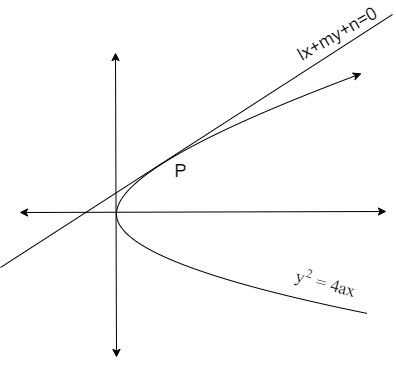
If the line \[lx+my+n=0\] touches the parabola \[{{y}^{2}}=4ax\] then prove that \[nl=a{{m}^{2}}\]
Answer
558.9k+ views
Hint: The rough figure that represents the given information is shown below.

We solve this problem by substituting the value of \['x'\] in terms of \['y'\] from the line equation in the parabola equation. We know that if the line touches a parabola that means the line and parabola have only one point of intersection.
So, by substituting the line equation in parabola we get the quadratic equation of \['y'\] where we make the discriminant equal to 0 as there is only one point of intersection.
The discriminant of \[a{{x}^{2}}+bx+c=0\] is given as \[\Delta ={{b}^{2}}-4ac\]
Complete step-by-step solution
We are given that the equation of parabola as
\[{{y}^{2}}=4ax....equation(i)\]
We are given that the equation of line that touches the parabola as
\[lx+my+n=0\]
Now, let us find the value of \['x'\] in terms of \['y'\] then we get
\[\begin{align}
& \Rightarrow lx=-my-n \\
& \Rightarrow x=-\dfrac{m}{l}y-\dfrac{n}{l} \\
\end{align}\]
We know that if the line touches a parabola that means the line and parabola have only one point of intersection.
We know that we substitute one equation in other equation to find the point of intersection/
Now, by substituting the this value of \['x'\] in equation (i) we get
\[\begin{align}
& \Rightarrow {{y}^{2}}=4a\left( -\dfrac{m}{l}y-\dfrac{n}{l} \right) \\
& \Rightarrow {{y}^{2}}+\dfrac{4am}{l}y+\dfrac{4an}{l}=0.......equation(ii) \\
\end{align}\]
Here, we can see that we got the quadratic equation in \['y'\]
We know that if there is a one point of intersection that means the discriminant will be zero.
We know that the discriminant of \[a{{x}^{2}}+bx+c=0\] is given as \[\Delta ={{b}^{2}}-4ac\]
Now, by using the discriminant formula for equation (ii) we get
\[\begin{align}
& \Rightarrow {{\left( \dfrac{4am}{l} \right)}^{2}}-4\left( 1 \right)\left( \dfrac{4an}{l} \right)=0 \\
& \Rightarrow \dfrac{16{{a}^{2}}{{m}^{2}}}{{{l}^{2}}}=\dfrac{16an}{l} \\
\end{align}\]
Now, by cross multiplying the terms in the above equation we get
\[\Rightarrow a{{m}^{2}}=nl\]
Hence the required result has been proved.
Note: We have a direct condition for a tangent of a parabola.
If \[y=Mx+c\] is the tangent to \[{{y}^{2}}=4ax\] then \[c=\dfrac{a}{M}\]
We have the line equation as
\[\begin{align}
& \Rightarrow lx+my+n=0 \\
& \Rightarrow y=\left( \dfrac{-l}{m} \right)x+\left( \dfrac{-n}{m} \right) \\
\end{align}\]
Now, by comparing this line equation with the above line equation that is \[y=mx+c\] we get
\[\begin{align}
& \Rightarrow M=\dfrac{-l}{m} \\
& \Rightarrow c=\dfrac{-n}{m} \\
\end{align}\]
Now, by using the standard condition that is \[c=\dfrac{a}{M}\] we get
\[\begin{align}
& \Rightarrow \dfrac{-n}{m}=\dfrac{a}{\left( \dfrac{-l}{m} \right)} \\
& \Rightarrow \dfrac{nl}{{{m}^{2}}}=a \\
& \Rightarrow nl=a{{m}^{2}} \\
\end{align}\]
Hence the required result has been proved.

We solve this problem by substituting the value of \['x'\] in terms of \['y'\] from the line equation in the parabola equation. We know that if the line touches a parabola that means the line and parabola have only one point of intersection.
So, by substituting the line equation in parabola we get the quadratic equation of \['y'\] where we make the discriminant equal to 0 as there is only one point of intersection.
The discriminant of \[a{{x}^{2}}+bx+c=0\] is given as \[\Delta ={{b}^{2}}-4ac\]
Complete step-by-step solution
We are given that the equation of parabola as
\[{{y}^{2}}=4ax....equation(i)\]
We are given that the equation of line that touches the parabola as
\[lx+my+n=0\]
Now, let us find the value of \['x'\] in terms of \['y'\] then we get
\[\begin{align}
& \Rightarrow lx=-my-n \\
& \Rightarrow x=-\dfrac{m}{l}y-\dfrac{n}{l} \\
\end{align}\]
We know that if the line touches a parabola that means the line and parabola have only one point of intersection.
We know that we substitute one equation in other equation to find the point of intersection/
Now, by substituting the this value of \['x'\] in equation (i) we get
\[\begin{align}
& \Rightarrow {{y}^{2}}=4a\left( -\dfrac{m}{l}y-\dfrac{n}{l} \right) \\
& \Rightarrow {{y}^{2}}+\dfrac{4am}{l}y+\dfrac{4an}{l}=0.......equation(ii) \\
\end{align}\]
Here, we can see that we got the quadratic equation in \['y'\]
We know that if there is a one point of intersection that means the discriminant will be zero.
We know that the discriminant of \[a{{x}^{2}}+bx+c=0\] is given as \[\Delta ={{b}^{2}}-4ac\]
Now, by using the discriminant formula for equation (ii) we get
\[\begin{align}
& \Rightarrow {{\left( \dfrac{4am}{l} \right)}^{2}}-4\left( 1 \right)\left( \dfrac{4an}{l} \right)=0 \\
& \Rightarrow \dfrac{16{{a}^{2}}{{m}^{2}}}{{{l}^{2}}}=\dfrac{16an}{l} \\
\end{align}\]
Now, by cross multiplying the terms in the above equation we get
\[\Rightarrow a{{m}^{2}}=nl\]
Hence the required result has been proved.
Note: We have a direct condition for a tangent of a parabola.
If \[y=Mx+c\] is the tangent to \[{{y}^{2}}=4ax\] then \[c=\dfrac{a}{M}\]
We have the line equation as
\[\begin{align}
& \Rightarrow lx+my+n=0 \\
& \Rightarrow y=\left( \dfrac{-l}{m} \right)x+\left( \dfrac{-n}{m} \right) \\
\end{align}\]
Now, by comparing this line equation with the above line equation that is \[y=mx+c\] we get
\[\begin{align}
& \Rightarrow M=\dfrac{-l}{m} \\
& \Rightarrow c=\dfrac{-n}{m} \\
\end{align}\]
Now, by using the standard condition that is \[c=\dfrac{a}{M}\] we get
\[\begin{align}
& \Rightarrow \dfrac{-n}{m}=\dfrac{a}{\left( \dfrac{-l}{m} \right)} \\
& \Rightarrow \dfrac{nl}{{{m}^{2}}}=a \\
& \Rightarrow nl=a{{m}^{2}} \\
\end{align}\]
Hence the required result has been proved.
Recently Updated Pages
A tunnel is dug across the diameter of the earth A class 11 physics CBSE

Each state is divided into different areas or for electoral class 11 social science CBSE

The IUPAC name of the following structure is CH3CHCH32CCH2CH3CCH3CCH2CH3 class 11 chemistry CBSE

A beam of light strikes a glass sphere of diameter class 11 physics CBSE

The moment of inertia of a uniform semi circular disc class 11 physics CBSE

Show that the total energy of particles performing class 11 physics CBSE

Trending doubts
10 examples of friction in our daily life

One Metric ton is equal to kg A 10000 B 1000 C 100 class 11 physics CBSE

Difference Between Prokaryotic Cells and Eukaryotic Cells

1 Quintal is equal to a 110 kg b 10 kg c 100kg d 1000 class 11 physics CBSE

State the laws of reflection of light

Explain zero factorial class 11 maths CBSE




